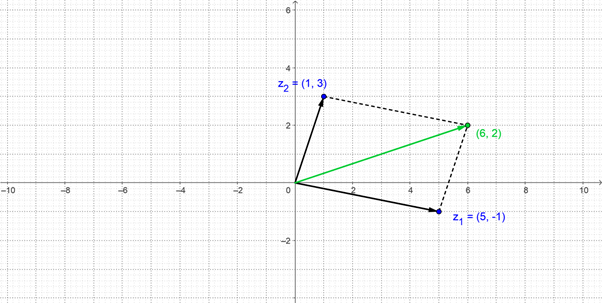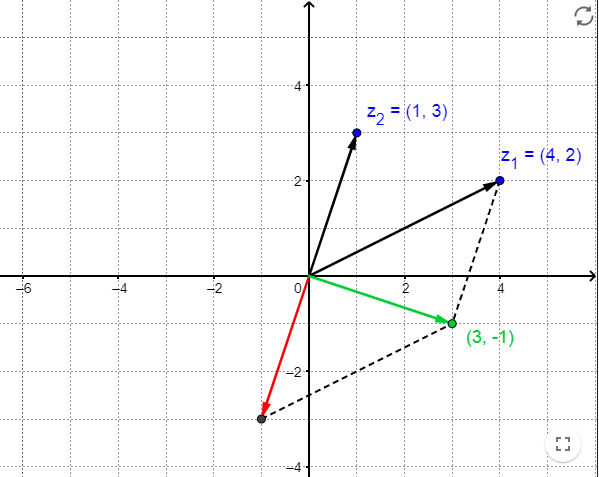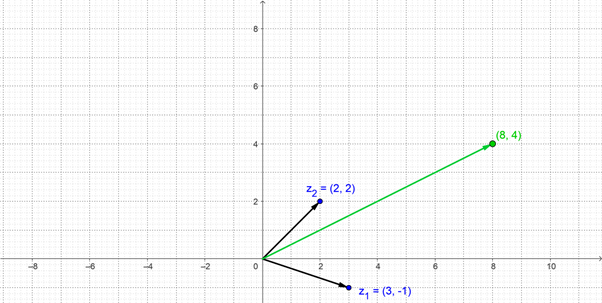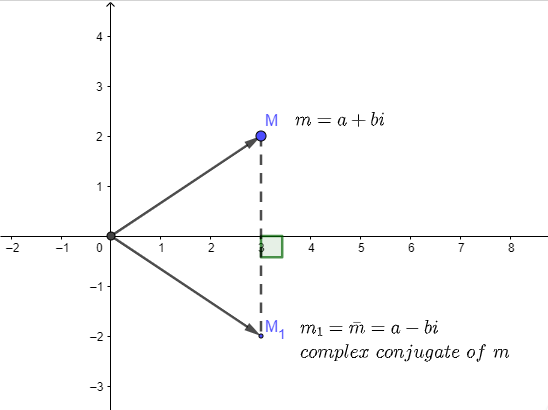Complex Number
Study Material:
Definition:
A complex number is a
number which can be expressed in the form ![]() where
where ![]() and
and ![]() are real numbers and
are real numbers and ![]() is the solution of the equation
is the solution of the equation ![]() and
and ![]() .
. ![]() is called imaginary number.
In a complex number
is called imaginary number.
In a complex number![]() ,
, ![]() is called real part and
is called real part and ![]() is called imaginary part. It is also written
as
is called imaginary part. It is also written
as ![]() . Here
. Here ![]() and
and ![]() .
.
Example:
![]() etc.
etc.
The set of complex numbers is denoted
by![]() . Since
any real number
. Since
any real number ![]() can be written as
can be written as ![]() so all real numbers are complex numbers. But
all complex are may not be real numbers. As example
so all real numbers are complex numbers. But
all complex are may not be real numbers. As example ![]() is not a real number.
is not a real number.
Graphical
representation:
![]() - Axis
is called real axis and
- Axis
is called real axis and ![]() -axis is
called imaginary axis. If
-axis is
called imaginary axis. If ![]() both are positive then the graphical
representation of
both are positive then the graphical
representation of ![]() is as the figure. So here we can see that
is as the figure. So here we can see that ![]() lies on real axis and
lies on real axis and ![]() lies on imaginary axis.
lies on imaginary axis.

Power of:
Since![]() . So
. So![]() ,
, ![]()
Continuing this process we
will get![]() , where
, where
![]() an
integer is.
an
integer is.
Complex
conjugate of complex number:
Let ![]() be a complex
number then its complex conjugate is given by
be a complex
number then its complex conjugate is given by ![]()

Modulus of complex number:
Let ![]() then the modulus of
then the modulus of ![]() is denoted by
is denoted by ![]() and defined by a non-negative real number
and defined by a non-negative real number
|
|
Addition
of two complex numbers:
Two complex are added by
separately adding their real and imaginary parts.
Let ![]() and
and ![]() . Then
. Then
![]()
Geometric
interpretation:
The sum of two complex
Numbers ![]() and
and ![]() interpreted as point obtain by Building a
parallelogram whose two adjacent sides are
interpreted as point obtain by Building a
parallelogram whose two adjacent sides are ![]() and
and![]() .
.
Addition of two complex number
satisfies closer, associative, commutative, existence of identity and existence
of inverse properties.

In general if ![]() then
then
![]()
Subtraction
of two complex numbers:
Two complex are subtracted by
separately subtracting their real and imaginary parts.
Let ![]() and
and![]() . Then
. Then
![]()
Geometric
interpretation:
![]() is the addition
of
is the addition
of ![]() and
and ![]() , whose
geometrical representation is shown in
the figure.
, whose
geometrical representation is shown in
the figure.

Multiplication
of two complex numbers:
Let ![]() and
and![]() . Then
their multiplication
. Then
their multiplication

Geometric
interpretation:
The
geometric interpretation of complex
numbers ![]() and
and ![]() is
stretching and rotation of vectors in the plan, shown in the figure.
is
stretching and rotation of vectors in the plan, shown in the figure.

Division
of two complex numbers:
Let ![]() and
and ![]() where
where![]() . Then
their division is given by
. Then
their division is given by

![]()
![]()
Example
1: Express ![]() in
the form of
in
the form of![]() .
.
Solution:
![]()
![]()
![]() .
.
Example
2: Express ![]() in the form of
in the form of![]() .
.
Solution:
![]()
![]() .
.
Some
important result in complex number: If ![]() and
and ![]() be two complex numbers. Then
be two complex numbers. Then
(i)
![]()
(ii) ![]() provided
provided ![]()
(iii)
![]()
(iv)
![]()
(v)
![]() provided
provided ![]()
Exercise of NCERT book
Express
each of the complex number given in the exercise 1 to 10 in the form![]() .
.
1.
![]()
Solution:
![]()
2.
![]()
Solution:
![]()
![]()
3.
![]()
Solution:
![]() .
.
4.
![]()
Solution:
![]()
![]() .
.
5.
![]()
Solution:
![]()
![]() .
.
6.
![]()
Solution:
![]()
![]()
7.
![]()
Solution:
![]()
![]()
![]()
8.
![]()
Solution:
![]()
![]()
![]()
9.
![]()
Solution:
![]()
![]()
![]()
10.
![]()
Solution:
![]()
![]()
![]()
![]() .
.
Find
the multiplicative inverse of each of the complex numbers given in the exercise
11 to 13.
11.
![]()
Solution:
Let ![]()
Then ![]() and
and ![]()
So the multiplicative inverse
of ![]() is given by,
is given by,
![]() .
.
12.
![]()
Solution:
Let ![]() . Then
. Then ![]() and
and
![]()
So the multiplicative inverse
of ![]() is given by,
is given by,
![]() .
.
13.
![]()
Solution:
Let ![]() Then
Then ![]() and
and
![]()
So the multiplicative inverse
of ![]() is given by,
is given by,
![]() .
.
14.
Express the following expression in the
form![]() .
.
![]()
Solution:
![]()
![]()
![]() .
.
Polar
representation of complex number:
![]() Let P represent a non-zero complex
number
Let P represent a non-zero complex
number

![]() . Let
. Let ![]() be the polar coordinate of the point P. where
be the polar coordinate of the point P. where ![]() is the distance OP and
is the distance OP and ![]()
be the angle
which makes OP with the positive ![]() -axis.
-axis.
Then ![]() and
and ![]() i.e.,
i.e., ![]() .
.
![]() Then
Then ![]() and
and
![]() .
.
![]() is called modulus of
is called modulus of ![]() and is denoted by
and is denoted by ![]() and
and ![]() is called argument of
is called argument of ![]() and is denoted by
and is denoted by![]() .
.
Now arg ![]() , when
, when ![]() lies in 1st quadrant
lies in 1st quadrant
![]() When
When ![]() lies in 2nd quadrant
lies in 2nd quadrant
![]() , when
, when ![]() lies in 3rd quadrant
lies in 3rd quadrant
![]() When
When ![]() lies in 4th quadrant.
lies in 4th quadrant.
Exercise of NCERT
Find
the modulus and arguments of each of the complex numbers in exercise 1 to 2.
1.
![]()
Solution:
Here ![]() and
and ![]()
Then modulus ![]()
And ![]() lies in 3rd quadrant. So argument
of
lies in 3rd quadrant. So argument
of ![]() is
is
![]() .
.
2.
![]()
Solution:
Here ![]() and
and ![]()
So ![]()
Since ![]() lies in 2nd quadrant. So
lies in 2nd quadrant. So
![]() .
.
Convert
each of the complex numbers given in the expression 3 to 8 in polar form:
3.
![]() .
.
Solution:
Let ![]() . Then
. Then ![]() and
and ![]()
So ![]()
Since ![]() lies in 4th quadrant so
lies in 4th quadrant so
![]()
Polar form of ![]() is
is![]() .
.
4.
![]() .
.
Solution:
Let ![]() . Then
. Then ![]() and
and ![]()
So ![]()
Since ![]() lies in 2nd quadrant so
lies in 2nd quadrant so
![]()
Polar form of ![]() is
is ![]() .
.
5.
![]() .
.
Solution:
Let ![]() . Then
. Then ![]() and
and ![]()
So ![]()
Since ![]() lies in 3rd quadrant so
lies in 3rd quadrant so
![]()
Polar form of ![]() is
is ![]() .
.
6.
-3.
Solution:
Let ![]() then
then ![]() and
and ![]()
So ![]()
![]() Lies in 2nd quadrant.
Lies in 2nd quadrant.
![]()
![]()
![]()
![]() .
.
7.
![]() .
.
Solution:
Here ![]() . So
. So ![]() and
and![]() .
.
Here ![]() lies in 1st quadrant. So
lies in 1st quadrant. So
![]() And
And![]() .
.
So the polar representation
of ![]() is
is![]() .
.
8.
![]() .
.
Solution:
![]() .
.
Comparing ![]() with
with ![]() we have
we have
![]() ,
, ![]()
![]()
And
![]()
Hence ![]() .
.
Quadratic equation
The equation of the form![]() , where
, where
![]() are real and
are real and ![]() is called quadratic equation.
is called quadratic equation.
The solution of this equation
is given by
![]()
Now if ![]() then this quadratic equation will have
imaginary roots.
then this quadratic equation will have
imaginary roots.
This quadratic equation has at least one root.
Exercise of NCERT
Solve
each of the following equatin:
1.
![]()
Solution:
![]()
![]()
2.
![]()
Solution:
![]()
![]()
3.
![]()
Solution:
![]()
![]() .
.
4.
![]()
Solution:
![]()
![]()

![]() .
.
5.
![]()
Solution:
![]()
![]() .
.
6.
![]()
Solution:
![]() .
.
7.
![]()
Solution:
![]() .
.
8.
![]()
Solution:

![]() .
.
9.
![]()
Solution:
 .
.
10.
![]()
Solution:
 .
.
11.
Convert ![]() into polar form
into polar form
Solution:
Let ![]()
![]()
![]() .
.
|
|
So
![]()
Since ![]() lies in 2nd quadrant so
lies in 2nd quadrant so
![]()
Polar form of ![]() is
is
![]() .
.
TRIGNOMETRIC OR POLAR FORM:
Let z = x + iy be a complex
number represented by a point P(x, y) in the Argand plane. Then by geometrical
representation we have
![]()
![]()

![]()
![]() OP =
OP = ![]() and
and ![]() ϴ = arg (z)
ϴ = arg (z)
P(x, y)
O ϴ
M
![]() In POM, we have
In POM, we have
Cos ϴ = ![]() =
= ![]() implies x =
implies x = ![]() cos ϴ
cos ϴ
sin ϴ
= ![]() =
= ![]() implies
y =
implies
y = ![]() sin ϴ
sin ϴ
z = ![]() (cos ϴ + i sin ϴ)
(cos ϴ + i sin ϴ)
z = r
(cos ϴ + i sin ϴ) where ![]() = r and ϴ = arg (z)
= r and ϴ = arg (z)
This
form of z is called the polar form of z.
In
general, z = ![]() (cos (2n
(cos (2n![]() + ϴ) + i sin (2n
+ ϴ) + i sin (2n![]() + ϴ)) where
+ ϴ)) where ![]() = r and ϴ = arg (z)
= r and ϴ = arg (z)
In the
graph plotted below, complex number in the polar (or trigonometric) form has
been represented. The complex number z = 2.29 + 1.47i

EQUALITY OF COMPLEX
NUMBERS:
Let us
take 2 complex numbers z₁ and z₂ where
z₁
= a₁ + i b₁
And z₂
= a₂ + i b₂.
Then
z₁ and z₂ are said to be equal iff a₁ = a₂ and b₁ = b₂.
ALGREBRA OF COMPLEX NUMBERS
1. ADDITION OF COMPLEX NUMBERS:
The
addition of 2 complex numbers z₁ = a₁ + ib₁ and z₂ =
a₂ + ib₂
z₁ + z₂ = (a₁ +
ib₁) + (a₂ + ib₂)
= (a₁ + a₂) + i (b₁ +
b₂)
Similarly
we can add z₁ , z₂ ,
z₃ , z₄ ,
. , zn as
z₁ + z₂ +
. + zn = (a₁ + ib₁) + (a₂ + ib₂)
+
+ (an + ibn)
= (a₁ + a₂ +
+ an) + i
(b₁ + b₂ +
+ bn)
Example:
Consider 2 complex numbers z₁ = 1 + 3i and z₂ = 5 1i. What will
be z₁ + z₂ =?
Solution:
z₁ + z₂ = (1 + 3i) + (5 1i)
= (1 + 5) + i (3
1)
= 6 + 2i
The graph plotted below is the Victoria representation of
addition of complex numbers.

2.
SUBTRACTION OF COMPLEX NUMBERS:
The
subtraction of 2 complex numbers z₁ = a₁ + ib₁ and z₂ =
a₂ + ib₂
z₁ - z₂ = (a₁ + ib₁) - (a₂ +
ib₂)
= (a₁
- a₂) + i (b₁ - b₂)
Similarly we can add z₁, z₂,
z₃, z₄
zn
z₁ - z₂ -
. - Zn = (a₁ +
ib₁) - (a₂ + ib₂) -
- (an + ibn)
=
(a₁ - a₂ -
- an) + i
(b₁ - b₂ -
- bn)
Example:
Subtract z₁ = 1 + 3i from z₂ = 4 + 2i.
Solution:
z₁
= 1 + 3i
z₂ = 4 + 2i
z₂
- z₁ = (4 + 2i) - (1 + 3i)
= (4 1) + (2 3) i
= 3 i
In the graph plotted below, it is clear that
negative of z₂ = 1 + 3i is taken.
It is so because we subtracting z₂ from z₁. So, we can write
z₂ - z₁ = (4 +
2i) - (1 + 3i)
= (4 + 2i) + (-1 + (-3) i)
= 3 - i

3.
MULTIPLICATION OF
COMPLEX NUMBERS:
The multiplication of 2 complex numbers z₁ = a₁ + ib₁
and z₂ = a₂ + ib₂
Z₁ x z₂ = (a₁ + ib₁)
x (a₂ + ib₂)
= (a₁a₂ - b₁b₂) +
i (a₁b₂ + a₂b₁)
= (
Re(z₁)Re(z₂) Im(z₁)Im(z₂) ) + i
(Re(z₁)Im(z₂) + Re(z₂)Im(z₁) )
NOTE:
The product z₁ x z₂
can also be obtained if we actually carryout the multiplication (a₁ +
ib₁) x (a₂ + ib₂) as given below:
(a₁ + ib₁) x (a₂ +
ib₂) = a₁a₂ + ia₁b₂ + ia₂b₁ + ![]() b₁b₂)
b₁b₂)
= (a₁a₂ - b₁b₂) + i (a₁b₂
+ a₂b₁)
Example: Multiply z₁ = 3 - i and
z₂ = 2 + 2i.
Solution:
We know that
Z₁
x z₂ = (a₁a₂ - b₁b₂) + i (a₁b₂ +
a₂b₁)
Z₁ = 3 - i = a₁ +
ib₁
Z₂ = 2 + 2i = a₂ +
ib₂
Z₁ x z₂ = 8 + 4i
The graph plotted below is the vectorial
representation of the above example.

4.
DIVISION OF COMPLEX NUMBERS:
The division of a complex number z₁ by a non
- zero complex number z₂ is defined as the multiplication of z₁ by
the inverse of z₂ and is denoted by![]() .
.
Thus, ![]() = z₁ x (
= z₁ x (![]() ) =
z₁ x (
) =
z₁ x ( ![]() )
)
The division of 2 complex numbers z₁ =
a₁ + ib₁ and z₂ = a₂ + ib₂
![]() =
= ![]()
To further simplify it
we will rationalize it by multiplying numerator and denominator by a₂ -
ib₂. By doing this we will get denominator as real number and we can
easily separate the real and imaginary part.
![]() =
= ![]()
= ![]() x
x ![]()
= ![]() x
x ![]()
= ![]()
= ![]() + i
+ i ![]()
The graph plotted below is an example of
vectorial representation of a division of 2 complex numbers z₁ = 24.46 + 8.02i
and z₂ = 2.01 3.41i.

CONJUGATE OF A COMPLEX NUMBER
Let z = a +
ib be a complex number. Then the conjugate of z is denoted by ![]() and is equal to a ib.
and is equal to a ib.
z = a + ib → ![]() a ib
a ib
It follows
from the definition that conjugate of a complex number is obtained by replacing
i by i.
The graph
plotted below is the vectorial representation of a conjugate of complex number.

Theorem: Let z₁, z₂ and z₃ be the
complex numbers. Then,
1.
![]() = z
= z
Proof:
Let
z = a + ib
![]() = a ib
= a ib
![]() =
= ![]() =
= ![]() = z
= z
Hence proved.
2. Z + ![]() = 2 Re (z)
= 2 Re (z)
Proof:
Let z = a + ib
![]() = a ib
= a ib
z + ![]() = (a + ib) + (a ib)
= (a + ib) + (a ib)
= 2a = 2 Re (z)
Hence proved.
3.
z - ![]() = 2 Im ( z )
= 2 Im ( z )
Proof:
Let z = a + ib
![]() = a ib
= a ib
z - ![]() = (a + ib) - (a
ib)
= (a + ib) - (a
ib)
= 2ib = 2 i Im (z)
Hence proved.
4.
If z =
![]() , then z is purely real.
, then z is purely real.
Proof:
Let
z = a + ib
![]() = a ib
= a ib
z = ![]()
i.e. (a + ib) = (a ib)
2 x ib = 0
2 x Im (z) = 0
Im (z) = 0
Thus, z is
purely real
Hence proved.
5. z + ![]() = 0 implies z is purely imaginary.
= 0 implies z is purely imaginary.
Proof:
Let
z = a + ib
![]() = a ib
= a ib
z
+ ![]() = (a + ib) + (a ib)
= (a + ib) + (a ib)
= 2a
= 2 Re (z) = 0
Implies
a = 0
Therefore,
z is purely imaginary.
Hence proved.
6. z ![]() =
= ![]()
Proof:
z ![]() = (a + ib) x (a ib)
= (a + ib) x (a ib)
= ![]()
=
![]()
Hence proved.
MODULUS OF A COMPLEX NUMBER:
The modulus
of a complex number z = a + ib is
denoted by ![]() and is defined as
and is defined as
![]() =
= ![]() =
= ![]()
Clearly, ![]()
![]() 0 for all z є Ȼ
0 for all z є Ȼ
The graph
plotted below shows the modulus of a complex number.

Theorem: If z₁, z₂,
z₃ є Ȼ, then
i.
![]()
![]() = 0
z = 0 i.e. Re( z ) = Im( z ) = 0
= 0
z = 0 i.e. Re( z ) = Im( z ) = 0
Proof:
![]() = 0
= 0
![]()
![]() = 0
= 0
![]()
![]() = 0
= 0
![]() a = 0 and b = 0
a = 0 and b = 0
![]() Re
(z) = Im (z) = 0
Re
(z) = Im (z) = 0
Hence proved
.
ii.
![]() =
= ![]() =
= ![]()
Proof:
Let z = a +
ib. Then, ![]() = a ib and z = - a ib
= a ib and z = - a ib
![]() =
= ![]()
![]() =
= ![]() =
= ![]()
![]() =
= ![]() =
= ![]()
Hence, ![]() =
= ![]() =
= ![]()
Hence proved.
iii.
- ![]()
![]() Re
(z)
Re
(z) ![]()
![]() ; -
; - ![]()
![]() Im
(z)
Im
(z) ![]()
![]()
Proof:
- ![]()
![]() a
a ![]()
![]() and
-
and
- ![]()
![]() b
b ![]()
![]()
- ![]()
![]() Re
(z)
Re
(z) ![]()
![]() and
-
and
- ![]()
![]() Im
(z)
Im
(z) ![]()
![]()
Hence proved.
iv.
z x ![]() =
= ![]()
Proof:
Let z =
a + ib and ![]() = a ib
= a ib
Then, z x ![]() = (a + ib) (a ib)
= (a + ib) (a ib)
= ![]() +
+ ![]() =
= ![]() =
= ![]()
RECIPROCAL OF COMPLEX NUMBER:
Let z = a +
ib be a complex number. Then the reciprocal of z is denoted by ![]() , where
, where ![]() .
.
![]()
Multiplying
both numerator and denominator by the conjugate ![]() of z
of z
= ![]() x
x ![]()
= ![]()
= ![]()
= ![]() - i
- i ![]()
Thus, the multiplicative inverse of a non
zero complex number z is same as its reciprocal and is given by
![]() + i
+ i ![]() =
= ![]() .
.
SQUARE
ROOTS OF A COMPLEX NUMBER:
Consider a
complex number z = a + ib such that ![]() = x + iy. Here both x and y are real
numbers. Then,
= x + iy. Here both x and y are real
numbers. Then,
![]() = x + iy
= x + iy
a + ib =![]()
=(![]() ) + 2 i
xy
) + 2 i
xy
Equating
the real and imaginary part
a
= (![]() )
)
b = 2 xy
Now,
(![]() ) ² =
) ² = ![]() + 4
+ 4![]()
(![]() ) ² =
) ² = ![]() +
+ ![]()
(![]() ) =
) = ![]()
On further
solving the equation we can conclude,
![]() =
= ![]() {
{ ![]() + i
+ i ![]() } , if Im (z) > 0
} , if Im (z) > 0
![]() =
= ![]() {
{ ![]() - i
- i ![]() } , if Im (z) < 0
} , if Im (z) < 0
Here is a
vectorial representation of the square root of one of the complex number.
Question: Find
the square root of 7 24i.
Solution:
Let ![]() = x + iy.
= x + iy.
7 4i = ![]()
7 4i = (![]() ) + 2 i
xy
) + 2 i
xy
Equating the real and imaginary part
7 = (![]() ) --------- (1)
) --------- (1)
-24 = 2 xy
-------- (2)
Now,
(![]() ) ²=
) ²=![]() + 4
+ 4![]()
(![]() ) ²= 49
) ²= 49
(![]() ) = 25 -------- (3)
) = 25 -------- (3)
On solving the values for x and y from the equations (1) and
(2), we get
![]() = 16
implies x =
= 16
implies x = ![]() 4
4
![]() = 9
implies y =
= 9
implies y = ![]() --------Since
in (2),
--------Since
in (2),
2 xy is
negative, so we will take the values of x and y of opposite sign.
i.e.
either x = 4 and y = -3 or
x = -4 and y = 3
Hence, ![]() =
= ![]() .
.